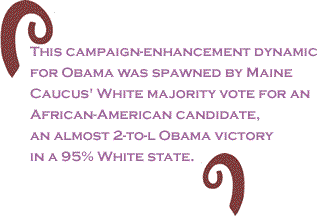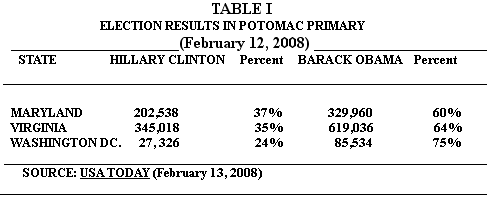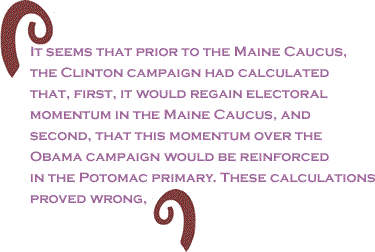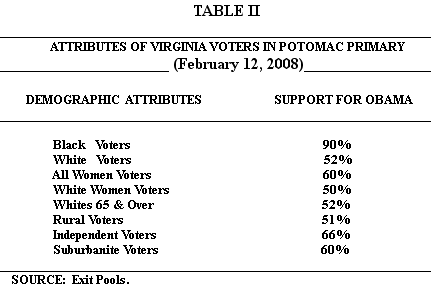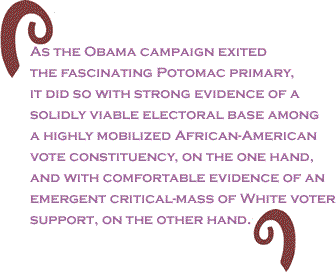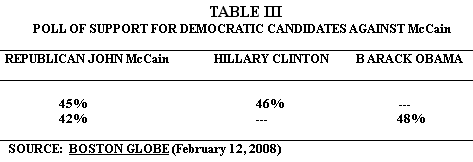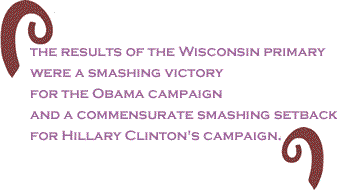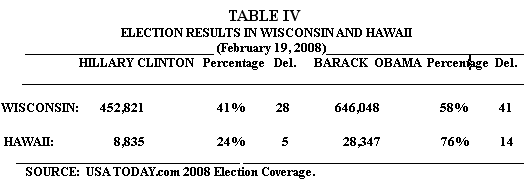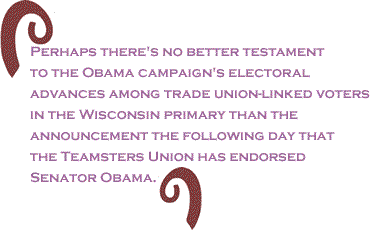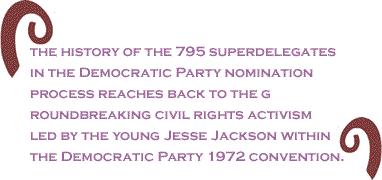
|
|||||||||||||||||||||
 |
|||||||||||||||||||||
 |
||||||||||
|
||||||||||
|
The current issue is always free to everyone If
you need the access available to a |
||||||||||
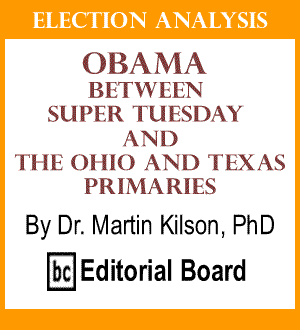 |
||||||||||
 |
||||||||||
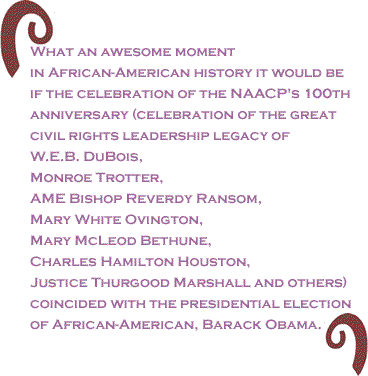 |
||||||||||
New Dynamics For Obama Campaign I concluded my second Black Commentator article (February 7) on Senator Barack Obama's campaign by observing that: “By any reasoned and balanced reckoning, the combined electoral results in the South Carolina January 26th primary and the Super Tuesday 22-state primary on February 5th were solidly beneficial for Barack Obama's campaign for the Democratic Party presidential nomination.” Furthermore, a week following Super Tuesday came the Potomac primaries on February 12th, which not only reinforced the Obama campaign's electoral viability but set-in-motion “new electoral dynamics” which, I suggest, will help to slowly but surely consolidate Senator Obama's quest to become the first African-American to gain the presidential nomination of a major political party. One of the ingredients contributing to these “new electoral dynamics” appeared glaringly just two days before the Potomac primaries, on Sunday, February 10th, in the Maine Caucus election, which Obama won by 59% to 40% for Hillary Clinton. While bringing an additional 15 delegates to Obama (9 to Clinton), an even more fundamental campaign-enhancement dynamic occurred in the Maine Caucus election. Namely, solid evidence that White voters are, shall we say, “racially maturing”—leaving the old vicious cocoon of American racism to enter a “new cultural-cosmopolitan American identity”, let's call it. Rather like a caterpillar that sheds its stifling cocoon to emerge into the butterfly's glorious freedom. This campaign-enhancement dynamic for Obama was spawned by Maine Caucus' White majority vote for an African-American candidate, an almost 2-to-l Obama victory in a 95% White state. A Maine Caucus voter who was interviewed by a reporter for the Boston Globe (February 11, 2008) formulated what I call a “racially maturing” dynamic among White voters this way: “It doesn't matter what color he is,” said Carolyn Krahn, a 49-year-old Obama supporter who participated in Freeport's caucus. “I think Maine is mature enough to vote for the better person.” Furthermore, Obama's Maine Caucus victory came as a shock to the Clinton campaign which, as the New York Times observed the following day, “Obama won 59 percent of the vote in a state that Mrs. Clinton had thought could be hers.” The Clinton campaign's off-balance situation resulting from Obama's Maine Caucus victory took stark form the next day—February 11th—when Clinton, as the New York Times (February 11) put it, “replaced her campaign manager [Patti Solis Doyle] and longtime aide in the biggest shakeup of her campaign to date. ...Patti Solis Doyle...led her campaign since it began last year and whom she regarded almost as an adopted daughter.” Doyle was replaced, interestingly enough, by an African-American, Maggie Williams, who has been a longtime aide to Hillary Clinton. As the New York Times reported, the political gravity of this campaign shake-up was absolutely fundamental: “The replacement of Ms. Doyle was in part a signal to donors and other supporters that the campaign was regrouping and was poised to right itself.” Obama Propelled Forward In Potomac Primary It seems that prior to the Maine Caucus, the Clinton campaign had calculated that, first, it would regain electoral momentum in the Maine Caucus, and second, that this momentum over the Obama campaign would be reinforced in the Potomac primary. These calculations proved wrong, an error that the New York Times reporter Katharine Seelye astutely characterized in her report on the implications of the dismissal of Patti Solis Doyle as Clinton's campaign manager:
As I suggested earlier in this article, the election results and exit polls for the Potomac primary in Maryland, Virginia, and Washington D.C., revealed solid evidence that the Obama campaign acquired “new electoral dynamics” --dynamics that were partly presaged in the Super Tuesday primaries and more fully presaged in the Maine primary. A central ingredient of the “new electoral dynamics” was what I call “racially-maturing White voters”, an electoral dynamic which, in turn, disturbed the confidence of the Clinton campaign. The headlines over reports on the Potomac primary in major newspapers indicated graphically the significance of Obama’s victory in the three elections. In the country's largest daily the USA Today (February 13, 2008): “Eight Losses In A Row Cost Clinton Delegate Lead.” In the Boston Globe (February 13, 2008): “Obama Stays On Roll With Sweep Along Potomac.” And in the Wall Street Journal (February 13, 2008): “Prediction Traders Put Their Money On Obama”.
While as a leftist intellectual I don't have very much confidence in the practices of money markets in regard to the needs of weak sectors among America's citizens, I was nevertheless interested in the Wall Street Journal editor's thinking on what I call the Obama campaign's “new electoral dynamics” --dynamics that have disturbed the confidence (nay, the center-of-gravity) of Hillary Clinton's campaign. Listen:
Furthermore, in the article titled on “Prediction Traders” there was additional evidence regarding the Wall Street Journal's thinking about the electoral dynamics that are propelling the Obama campaign. That stubbornly capitalist newspaper informs us that investors who gamble on non-capitalist events (e.g., horse racing, sports events, and elections) are, shall we say, “bullish on Obama.” Listen again:
The election results in the Potomac primary are shown in TABLE I. As the New York Times headlined its main article on the Potomac primary, “Obama Captures 3 More Contests By
Big Margins.” Not surprisingly, given the African-American population edge in Washington DC., (70% of the population) it was there that the largest victory margin occurred—75% Obama, 24% Clinton. However, in Maryland and Virginia where Whites are in the majority (Blacks are 29% of voters in Virginia and 37% in Maryland), there was a quite surprising victory margin for Obama. He registered a 2-to-1 electoral victory—60% to 37% in Maryland, and 64% to 35% in Virginia.
An analysis of the exit polls provides a sharper understanding of the electoral salience of Obama's victory in the Potomac primary, and also a feel for why investors in non-capitalist markets (e.g., horse races, sport events, etc.) are “bullish on Obama.” The February 13 New York Times' instructive overview summary of the results of exit polls for the Potomac primary informed us as follows:
Key demographic attributes of Virginia voters in the Potomac primary are provided in TABLE II. In general terms, what was important about the characteristics of voters in the borderline Southern state of Virginia is that Senator Barack Obama carried a majority of voters who were not African-Americans. As shown in TABLE II, these voters ranged across a broad
spectrum of Virginia's citizens—citizens in a Southern state that's 65% White. A combination of both the politically moral and politically strategic significance of the Obama's victory in Virginia's side of the Potomac primary was keenly underlined by the New York Times' prominent columnist Frank Rich, who grew-up on the Potomac River (in Washington) . For Frank Rich, Obama's victory in Virginia amounted to a seismic change:
This Frank Rich perspective on the Virginia side of Obama's solid victory in the Potomac primary was replicated in an overview analysis of exit polls' results provided in the progressive journal The Nation by the essayist Bob Moser. “Obama won pretty much every constituency he's presumed to be weakest with,” observed Moser in his article that was aptly titled “Purple Obama.” He proceeded to elaborate this perspective, noting that Obama won
Special Significance Of Black Voter Bloc To Obama Campaign I should mention that although Clinton held on to a majority of White women voters, Obama's loss among this voter bloc in Virginia was by only a 10% margin—a much smaller margin than the 25% margin by which he lost among White women a week earlier in the Super Tuesday primary. However, infinitely more basic to the Obama campaign has been the massive voter support from African-American women, a support consistently in the high 80% range throughout the Potomac primary. It must also be mentioned that the fundamentally crucial victory-sustaining vote for Obama's campaign among African-American voters not only held steady but increased in the Potomac primary. Indeed, without a steady-state massive Black voter bloc support for Obama's candidacy commencing in the South Carolina primary onward, we simply would not be discussing today a viable African-American politician's quest for the presidency of the United States.
This indispensable Black-voter-bloc undergirding foundation of Barack Obama's phenomenal campaign for the Democratic nomination (without which there would not in fact be a viable Obama campaign) was effectively underscored by the main political analyst for the Boston Globe, Peter Canellos. The Potomac primary results demonstrated that Obama's “support among black voters continues to grow,” observed Canellos. He continued:
What an awesome moment in African-American history it would be if the celebration of the NAACP's 100th anniversary (celebration of the great civil rights leadership legacy of W.E.B. DuBois, Monroe Trotter, AME Bishop Reverdy Ransom, Mary White Ovington, Mary McLeod Bethune, Charles Hamilton Houston, Justice Thurgood Marshall and others) coincided with the presidential election of African-American, Barack Obama. It is also noteworthy that right after the Potomac primary, additional evidence of the upright-and-in-stride position of Obama's campaign was reported in the Boston Globe (February 13, 2008): “A national poll released yesterday underscored the closeness of the race, suggesting that the two are in a statistical tie, Clinton with 45 percent and Obama with 44 percent.” Polls taken back in December 2007 had Clinton ahead between 15% and 23%, a Clinton advantage now erased. Further evidence of the upright-and-in-stride status of Obama's campaign is shown in TABLE III. It reports the most recent poll matching Obama and Clinton against the likely Republican presidential nominee, John McCain.
Meaning Of Wisconsin Primary For Ohio-Texas Primaries In the period following the Potomac primary on February 12th and the Wisconsin primary on February 19th, Hillary Clinton and the Clinton Machine put forth an upbeat public face despite the Obama campaign's primary victories—eight successive victories. Peter Canellos of the Boston Globe commented on the Clinton campaign's upbeat public face in this way:
The first test of the Clinton campaign's upbeat public face came on Tuesday, February 19th, in the Wisconsin primary. Two days before the Wisconsin vote on February 17th, the Bloomerg News agency reported rather ominous news in regard to Hillary Clinton's position in the large states of Wisconsin and Texas. That “Barack Obama picked up key newspaper endorsements in Wisconsin and Texas yesterday as he and Hillary Clinton compete for delegates in states that may help determine which candidate wins the Democratic presidential nomination.” The newspapers were the Milwaukee Journal Sentinel, the largest daily newspaper in Wisconsin, and the Houston Chronicle, the largest daily newspaper in Texas. The former explained its support for Obama in the Wisconsin primary because “change and experience are crucial to moving this country forward,” and it went on to identify Senator Obama as “best-equipped to deliver that change.” The latter also explained its support for Obama in the forthcoming Texas primary in March by characterizing Senator Obama as “the best-qualified by life experience, skill, and temperament to be the standard bearer for his party.”
As it happened, the results of the Wisconsin primary were a smashing victory for the Obama campaign and a commensurate smashing setback for Hillary Clinton's campaign. The Wisconsin results are shown in TABLE IV along with results for the Hawaii Caucus primary. As with
Obama's victory in the Potomac primary last week, the headlines over reports in major newspapers graphically announced Barack Obama's Wisconsin victory. In the Wall Street Journal (February 20, 2008): “ Obama Holds Off Clinton In Wisconsin.” In the New York Times (February 20, 2008): “Wisconsin Voters Hand Obama A Victory—His Ninth In A Row.” And in the USA Today (February 20, 2008): “Obama Adds To Victory Streak.” The special political aura enshrouding Senator Barack Obama's Wisconsin victory was communicated in the lead-off paragraph of the Wall Street Journal's frontpage report: “Barack Obama held off Hillary Clinton's belated attempt to brake his momentum in Wisconsin's Democratic primary, winning his ninth-straight presidential-nominating contest as the two get closer to the showdown Sen. Clinton has promised in Ohio and Texas two weeks away.” The Wall Street Journal's front-page report went on to inform its readers just how broadly the Obama campaign had penetrated voter blocs previously considered Hillary Clinton's electoral preserves:
In addition to the fact that Obama did well among a broad spectrum of Wisconsin primary voters, the newspaper and television reports gave special attention to Obama's election performance among two particular groups of White voters. One group was White males. The New York Times (February 20, 2008) reported as follows on this group: “About 6 in 10 white men voted for Mr. Obama, while white women split evenly between him and Mrs. Clinton, the polls showed.”
The second group was voters belonging to trade unions. The New York Times reported “About one-third of voters in the [Wisconsin] Democratic primary came from union households, and they split their votes evenly between Mrs. Clinton and Mr. Obama.... By contrast, in the Feb. 5 primaries in New Jersey and California—two states Mrs. Clinton won—the percentage of Democratic voters from union households was also about one-third...but they supported Mrs. Clinton more strongly than in Wisconsin.” Now one important development among trade union-linked voters since the Feb. primary in California and New Jersey has been the endorsement of Obama by three major unions, such as the Service Employees International Union. The electoral significance of this development was underscored in the main article on the Wisconsin primary carried in the Boston Globe (February 20, 2008):
Perhaps there's no better testament to the Obama campaign's electoral advances among trade union-linked voters in the Wisconsin primary than the announcement the following day (February 21st) that the Teamsters Union has endorsed Senator Obama. Clearly, that bulwark of conservative policies within the ranks of the Democratic Party wants to find a seat for itself on what it views as a potentially victorious Obama campaign bandwagon. Concluding Note: Delegate Dynamics & Obama Campaign There is, I suggest, no way to misconstrue the Obama campaign’s 2 to 1 electoral victory in the Wisconsin primary as anything but a significant development. One yardstick not yet mentioned in this article for measuring this significance was reported in exit polls. Namely: “That two-thirds of [Wisconsin] voters believed that Obama would be a stronger candidate in the fall and that he was more likely to unite the country.” (Boston Globe, February 20, 2008)
However, although Obama has the edge presently in the all-important Delegate Count (1,3l6 to Clinton's 1,241—according to Associated Press), he must muster some 2,025 delegates in order to conquer the Democratic nomination. Expert electoral analysts say that neither Obama nor Clinton is likely to muster 2,025 delegates by the time of the Democratic Party convention in August, which means that the special category of delegates called “Superdelegates” --795 of them-- will hold the nomination decision in their hands. Interestingly, the history of these 795 superdelegates in the Democratic Party nomination process reaches back to the groundbreaking civil rights activism led by the young Jesse Jackson within the Democratic Party 1972 convention. The then Vice President Hubert Humphrey—following President Lyndon Johnson's decision not to seek a second term—stealthily maneuvered the nomination at the 1968 Democratic convention, even though Senator Eugene McCarthy—the anti-Vietnam War candidate—had defeated Humphrey in all of the primaries. Jesse Jackson led a reform slate at the 1972 Democratic convention that sought for a proportional representation mechanism for allocating delegates to future nominating conventions, an arrangement that ended the longstanding winner-take-all principle that had applied in Democratic primaries. However, the Jackson-led liberal reform slate had to accept as a trade-off the arrangement for “superdelegates”, an arrangement that provided a decision-making role at the nominating convention for powerful established Democratic personalities like members of Congress, Governors, top mayors, top labor leaders, etc. Today, it is likely that the current primary contests will not produce a decisively victorious Democratic presidential nominee, so the 795 superdelegates will have a key decision-making role at the Democratic convention in August. The Clinton campaign is maneuvering to have the delegates for Florida and Michigan seated at the convention, even though those states broke the rules of the Democratic National Committee against altering the dates on which their primaries took place. Hillary Clinton, Barack Obama, and John Edwards formally agreed not to campaign in the Florida and Michigan primaries, but Clinton cynically reneged on this arrangement and subsequently reneged as well on the arrangement that the Florida and Michigan delegates would not be seated at the August Democratic nominating convention. The issue of seating the Florida and Michigan delegates has also sparked some disagreement among African-American civil rights figures, but I doubt this will amount to very much by the time of the Democratic nominating convention in August. I concur with Rev. Al Sharpton's position on this issue, who remarked in a letter to Howard Dean, head of the Democratic National Committee, that “I firmly believe that changing the rules now and seating delegates from Florida and Michigan at this point would not only violate the Democratic Party's rule of fairness, but also would be a grave injustice.” (Boston Globe, February 14, 2008) Finally, I also agree with the candid and pungent observation by the Professor Ron Walters, the University of Maryland political scientist and former adviser to Jesse Jackson's presidential campaigns, that “all hell would break loose” if Clinton-campaign influenced stealth maneuvers via superdelegates gained the day at the Democratic convention in August. By the phrase “all hell would break loose”, Professor Walters meant that “Blacks...could stay away from the polls in November in protest. ...That would hand the presidency to the Republicans.” (USA Today, February 15, 2008).
|
||||||||||
| February 21,
2008 Issue 265 |
|
| Executive Editor: Bill Fletcher, Jr. |
| Publisher: Peter Gamble |
| Printer Friendly Version in resizeable plain text format format |
 |
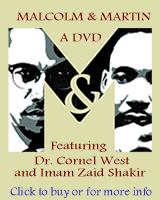 |
 |
 |
| |
| |





















